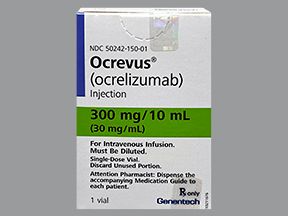The usual Ocrevus dosage for multiple sclerosis (MS) and clinically isolated syndrome is two starting infusions given 2 weeks apart, and then an infusion every 6 months.
Ocrevus (ocrelizumab) is prescribed to treat the following conditions in adults:
Ocrevus is a biologic drug. (Biologics are made from parts of living organisms.) It belongs to a group of drugs called monoclonal antibodies.
This article describes the dosages of Ocrevus, including its form, strength, and how the drug is given. To learn more about this drug, see this in-depth Ocrevus article.
Be sure to follow your doctor’s instructions about your Ocrevus dosing frequency.
What is Ocrevus’s form?
Ocrevus comes as a solution for intravenous (IV) infusion. This is an injection into a vein that’s given over time by a healthcare professional.
You’ll likely receive your dose of Ocrevus at a doctor’s office or an infusion center. But depending on your insurance provider, you may be able to receive your Ocrevus infusion at home.
What strength does Ocrevus come in?
Ocrevus comes in a strength of 300 milligrams (mg) per 10 milliliters (mL) of solution. This is also written as 30 mg/mL.
What is the typical dosage of Ocrevus?
The recommended Ocrevus dosage is as follows:
- Starting dosage: The initial dose of Ocrevus is a 300-mg infusion given over 2.5 hours or more. This is followed by another 300-mg dose 2 weeks later. These first doses of Ocrevus are lower than what you’ll eventually receive, so that your doctor can see how your body responds to the treatment.
- Maintenance dosage: After the first two doses, your Ocrevus dose will increase to 600 mg every 6 months. These 600-mg infusions may take 2 to 3.5 hours, or longer. If you experience an infusion-related reaction with your first doses, your infusion time may be longer than 3.5 hours.
If you have a reaction while receiving Ocrevus, the healthcare professional giving you the infusion may stop it and monitor you. Depending on how your body responds, they may restart the infusion or stop Ocrevus treatment.
How long can you receive Ocrevus?
Ocrevus is used as a long-term treatment. If you and your doctor determine that Ocrevus is safe and effective for you, you’ll likely receive it long term.
A healthcare professional will give you Ocrevus either at a doctor’s office, an infusion center, or maybe even at your home.
They’ll administer the drug as an intravenous (IV) infusion. This is an injection into a vein that’s given over time. Your first two doses will typically last about 2.5 hours, or more. The rest of your infusions will last 2 to 3.5 hours, or longer.
You’ll be monitored closely for side effects while you receive Ocrevus infusions. And before each infusion, you may be given an antihistamine, such as Benadryl (diphenhydramine), and a steroid, such as Medrol (methylprednisolone). You may also be given a drug to prevent fever, such acetaminophen (Tylenol, others). These medications help lower your risk of an infusion-related reaction.
If you miss an appointment to receive a dose of Ocrevus, call your doctor’s office or infusion center immediately. They’ll reschedule your infusion.
After receiving your missed dose, you’ll need to wait at least 5 months for your next dose. Your doctor’s office will adjust your dosage schedule if needed.
If you have questions or concerns about a missed dose of Ocrevus, talk with your doctor.
Q:
What happens if I miss my second starter dose (300-mg dose) of Ocrevus?
AnonymousA:
If you miss a dose of Ocrevus, you should contact your doctor’s office immediately. It’s important to get your dose as soon as possible and not wait for the next scheduled dose. Once you receive your missed dose, your doctor will schedule your next dose for 6 months from the date you received the missed dose.
The Healthline Pharmacist TeamAnswers represent the opinions of our medical experts. All content is strictly informational and should not be considered medical advice.Disclaimer: Healthline has made every effort to make certain that all information is factually correct, comprehensive, and up to date. However, this article should not be used as a substitute for the knowledge and expertise of a licensed healthcare professional. You should always consult your doctor or another healthcare professional before taking any medication. The drug information contained herein is subject to change and is not intended to cover all possible uses, directions, precautions, warnings, drug interactions, allergic reactions, or adverse effects. The absence of warnings or other information for a given drug does not indicate that the drug or drug combination is safe, effective, or appropriate for all patients or all specific uses.





